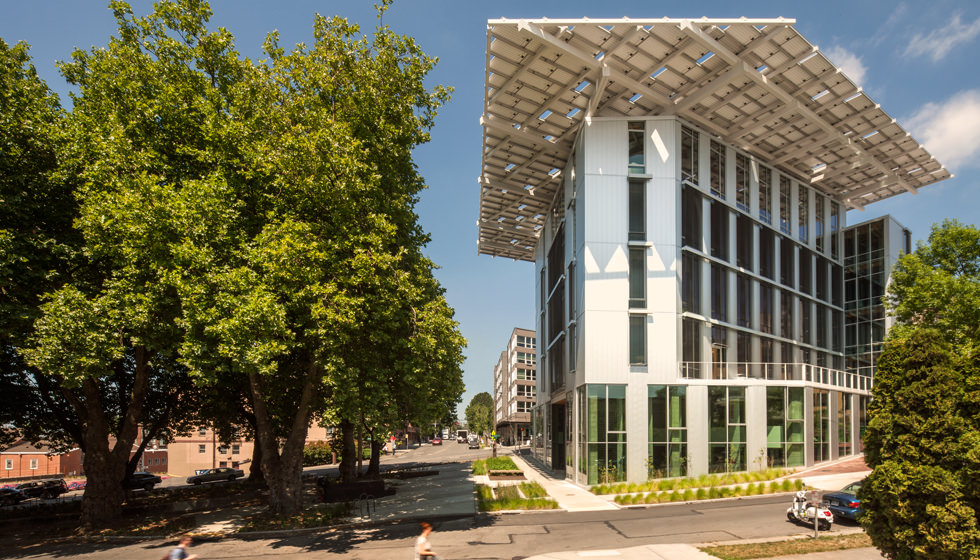Matt Grocoff's comparison of structure of a leaf and the structure of self-organizing, pre-industrial cities like Venice, Italy.
Essay and interview originally published on The Next Idea
If the first Industrial Revolution was characterized by centralization of our water, energy, food and organizational infrastructures, then the next Industrial Revolution will be characterized by the decentralization of these human-designed systems. Biomimicry, innovation inspired by nature, will be our framework for sustainable solutions to human challenges.
Michigan’s energy, water, agricultural and political infrastructures are linear, top-down grid systems. They are oversimplified design schemes that create an illusion of control that deny uncertainty. They lack diversity, resilience and innovation and are therefore weak.
In nature, over-simplicity is an indicator of disease and decline. Successful systems have a pattern of healthy variation and diversity. If we wish to sustain the climate to which we and all living things have adapted, then we need to design systems more like old growth forests and less like tree farms.
The Next Idea is to transition away from centralized infrastructure and create distributed systems that mimic nature. Nature depends on underlying decentralized networks. Nature doesn't do grids or straight pipes. Complex problems demand complex design.
The rules couldn’t be clearer. Biodiversity and complexity thrive. Radically simple solutions fail.
The future is local. Typically, when we think ‘local,’ we think food or shopping. But in nature, everything is based on adjacency. Local knowledge overrules distant command and control. What if our policies rewarded adjacency and encouraged local interaction in the way that nature demands?
Michigan, like all other states, has challenges that can’t wait.
Our aging centralized water infrastructure has reached the end of its useful life and threatens our rivers, lakes, aquifers and people. Our 20th-century energy grid is in need of modernization and is controlled by centralized monopolies. These unnatural monopolies no longer make sense with 21st-century technology that enables distributed production and ownership. Michigan’s diverse local & craft food system is threatened by disproportionate support for conventional linear commodity production. Our state government has increasingly centralized authority which has virtually eliminated innovation at the local level.
For systems to be sustainable and to thrive they need to assemble from the bottom up--they need to create conditions that are conducive to life. When we ignore the rules of nature we ignore the catastrophic risk posed by our centralized systems. By definition, thriving must promote thriving.
All these systems rely on top-down approaches that are nowhere to be found in nature. When they fail, they fail big. Alternatively, complex systems emerge from the bottom up. They grow and iterate, they are distributed but interconnected, and when they fail, they fail gracefully.
Imagine if Michigan innovators consulted with nature and sought solutions from its 3.8 billion-year-old design encyclopedia. Swarms, watersheds, flocks, neurons, whirlpools, nautilus shells or the cochlea of your ear all contain self-similar mathematical patterns that can inform and help us solve some of our greatest design challenges. Harvard astronomer Dr. Avi Loeb recently told the New York Times, “Nature teaches us that its imagination is better than ours.”
We need more biologists and diversity at our planning and policy tables. We need to find a way for our infrastructures to return more ecosystem services than they extract. “Can a city be generous?” author and innovation consultant Janine Benyus asks. “It has to be!” It is essential that we ask whether our water, energy, food and political systems are generous. Do they follow nature’s rules for thriving?
For systems to be sustainable and to thrive they need to assemble from the bottom up--they need to create conditions that are conducive to life. When we ignore the rules of nature we ignore the catastrophic risk posed by our centralized systems. By definition, thriving must promote thriving.
We are drawn to certain types of nature. We have an affinity for things that enhance life. Harvard biologist E. O. Wilson calls this innate desire “biophilia.” Wilson asks, “Where would we go if given a completely free choice?” Describing a basic principle of ecology he notes that “the crucial first step to survival in all organisms is habitat selection. If you get to the right place, everything else is going to be easier.”
As humans, we not only select our own habitat, we also design and build it. We have the ability to consider the past, and to project into the future. We can alter environments, extract and move materials, and hyper-engineer in ways no other species can, and in ways even our human ancestors couldn't fathom.
By embracing policies that encourage distributed design, Michigan will be staking out a prosperous and healthy future. The costs of failing to address our outdated water, food, and energy systems are getting worse with time and neglect. Globally, decentralized systems that mimic nature’s brilliance are gaining acceptance. Nature has proven this to be the only sustainable path.
Matt Grocoff is principal of the THRIVE Collaborative and an advisor to the University of Michigan BLUElab Living Building Challenge Team. You can read the first essay in Matt's series HERE.





